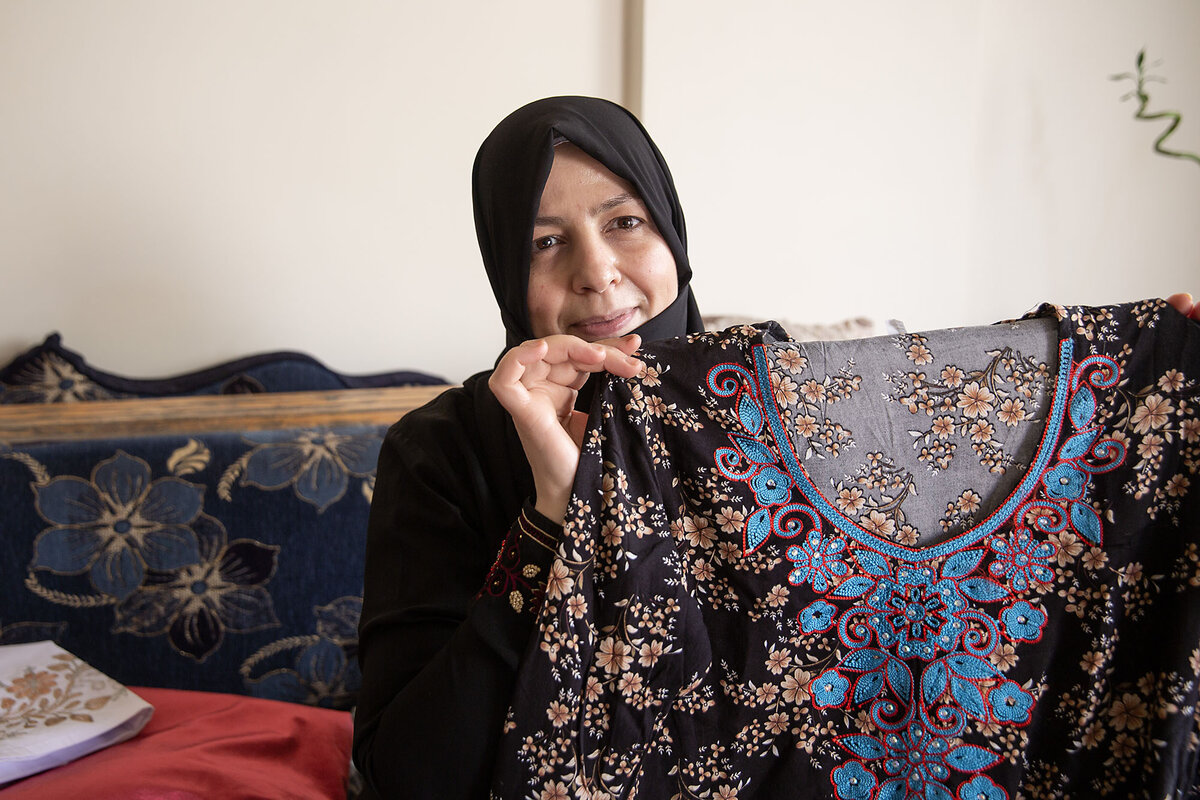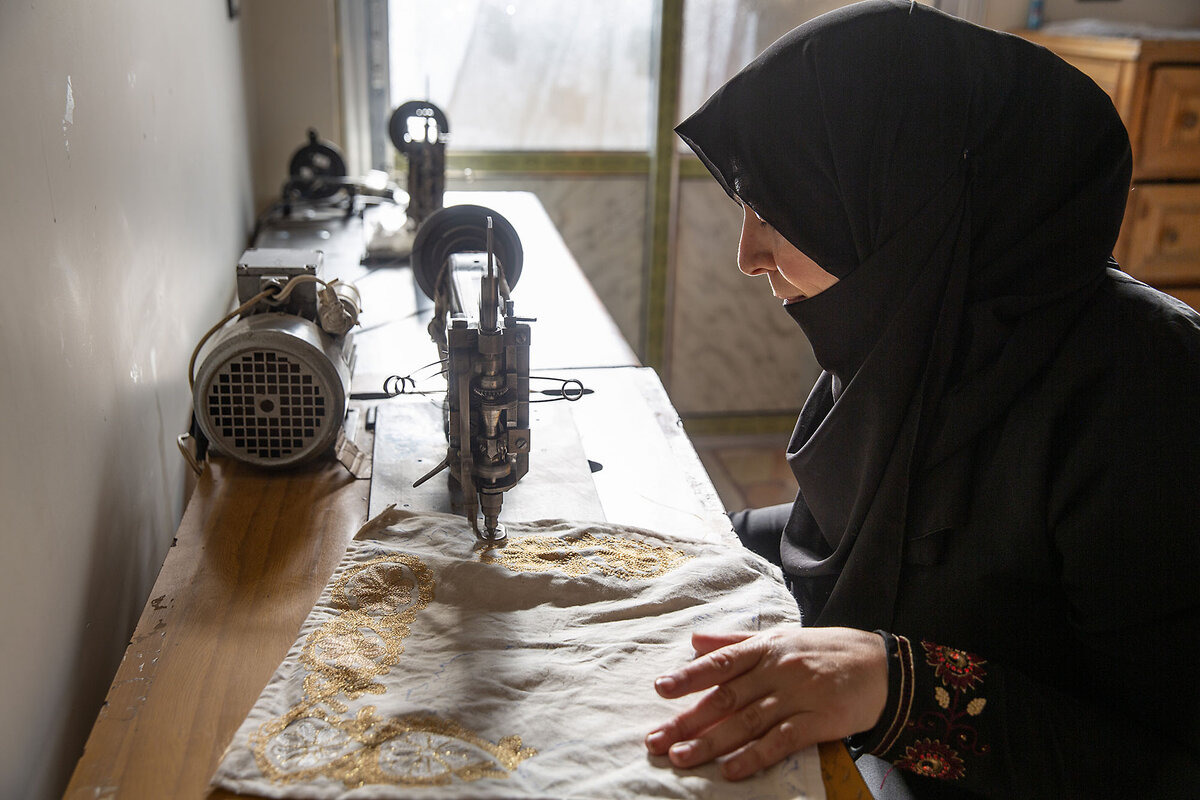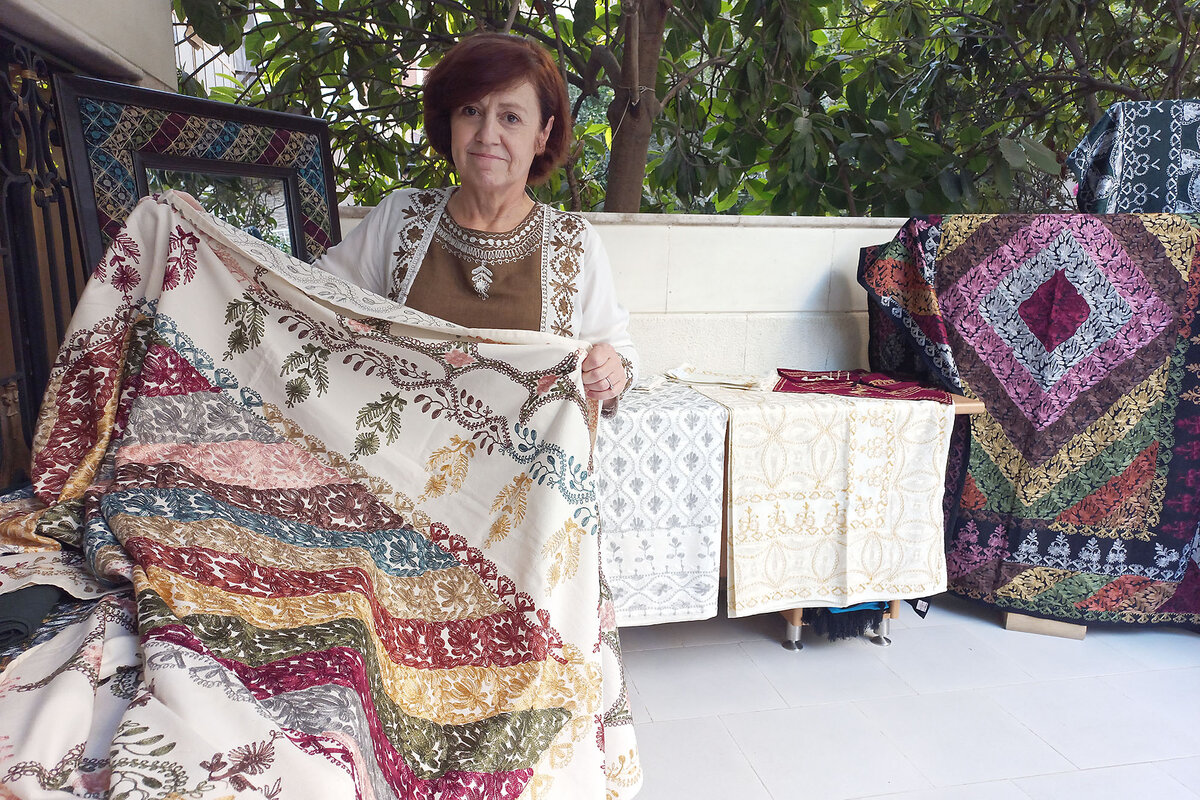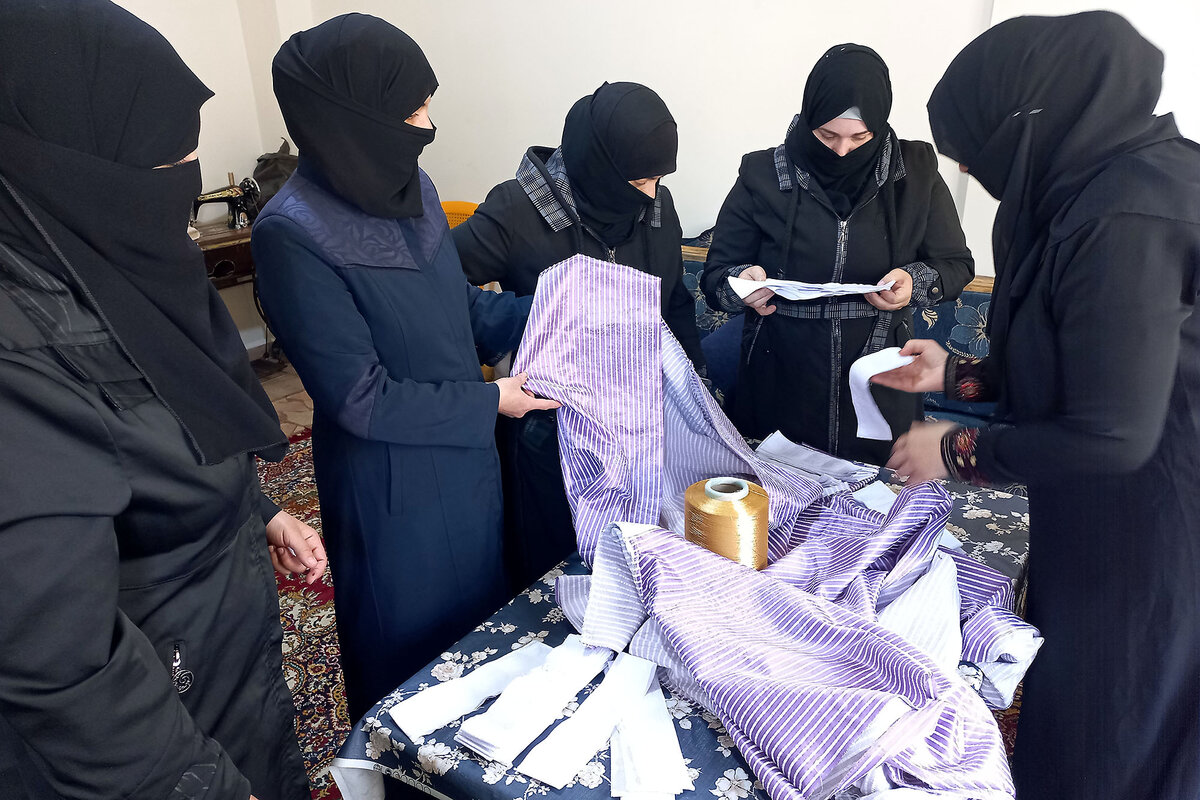After war’s destruction, Syrian seamstresses bring ancient craft to life
Loading...
| Douma, Syria
By the time Ameera al-Hammouri was 10, her hands were dancing across the taut fabric beneath her grandmother’s aghabani embroidery machine. She was too short to sit, so she stood, working the foot pedal to coax floral patterns from metallic thread and her own memory.
Decades later, in a rundown apartment building on the outskirts of Damascus, her machine now runs on an erratic supply of electricity. The building’s elevator no longer works and many of its windows are broken, but inside the sanctity of Ms. Hammouri’s spotless home, the artistry lives on.
“Working on the embroidery machine for me is like drawing on paper,” she says, sitting beside neat piles of embroidered tablecloths in her living room. Trays of sweets are set out for guests. “It’s the art inside me that I express through my work. Whatever I imagine, I bring to life with my hands.”
Why We Wrote This
Syria's civil war killed hundreds of thousands of people, but traditional embroidery survived in the care of a handful of women. Now, they hope to make a living from it again.
Aghabani embroidery originated in Damascus more than 150 years ago, blending Ottoman, Arabic, and Persian design influences. Traditionally, patterns were hand-printed in Damascus onto fabrics that were then sent to Douma, about 8 miles from the capital, where women embroidered them at home. Their work, displayed on tablecloths and other household items, became a hallmark of Syrian hospitality.
Today, the survival – indeed, the revival – of this craft tradition rests in the hands of women from Douma, a city synonymous with both resistance and ruin. The women behind these works are not only artisans. They are mothers, widows, and survivors of siege, displacement, and economic collapse.
Saved by embroidery
Ms. Hammouri herself endured all of it. Her husband and eldest son were arrested in 2012 and never returned. Douma was subjected to a five-year siege, when government forces surrounded the city, cutting it off from food, medicine, and fuel. Ms. Hammouri’s house was destroyed. As the bombs fell, she moved her children from house to house, basement to basement.
The siege ended in 2018. With no income and no husband, Ms. Hammouri turned to the one thing that had always grounded her: her original aghabani machine, bought in 1988 with money she scraped together by selling her wedding gold and other treasures. It still stands in a corner of her bedroom, alongside a newer model.
“I talk to this machine,” confides Ms. Hammouri, who is known in the community as Umm Meriee. “It holds my secrets. I’ve cried over it.”
At first, she worked quietly from home, taking orders from traders who remembered her family’s reputation and bought pieces for export. Over time, she began training other women.
If Syria’s current political opening brings more trade and tourism, she says, crafts like aghabani could once again become a source of stable income rather than just a means of survival.
Now, twice a week, her apartment fills with the chatter and laughter of industrious women. Tuesdays are for Umm Meriee’s core team of six, skilled at detailed pieces such as prayer rugs and bridal wear. On Thursdays, the larger group meets – 20 women, mostly housewives and widows, all trying to earn enough to meet their families’ needs.
This gathering of women is not a formal enterprise. There is no signboard or registration, no website to market their work. But family reputations endure in a country where word of mouth is the norm.
“They know my name in the market,” says Umm Meriee, recalling how she revived ties with shopkeepers in the Al-Hariqa market, in Damascus’ old city, because her aunts and grandmother had put the family name on the map. “When a woman brings in work and says she’s with Umm Meriee, they give her respect,” she says proudly.
Beautiful but hard to sell
For Mona al-Masri, a Tuesday regular, embroidery is her identity. She bought her own embroidery machine as a teenager and refused to leave it behind when she married. “Aghabani is the most beautiful thing in my life,” says the mother of four. “It reflects what’s inside me.”
While her colorful pieces earn heartfelt “wows” from her daughters, it is next to impossible to eke a living from this craft. In a good week, working three hours a day in between bouts of housework, Ms. Masri earns just over $6. Even women who devote more time to aghabani cannot earn enough to meet family expenses.
The market, the women say, is unkind to handmade work. Despite the skill and time aghabani requires – a single detailed motif can take hours, and a full tablecloth might take a week or more to complete – handmade aghabani cannot compete with cheaper, machine-made imitations that dominate the local market, such as those imported from China.
“Right now, aghabani has no future,” says Ms. Masri. But with government support, she feels that future could “be a very bright one.”
Mona Araghili shares that optimism. With the fall of President Bashar al-Assad and a new government pledging to rebuild the economy, she sees a renewed opportunity for serious investment in traditional crafts such as aghabani.
More than a decade ago, Ms. Araghili set up Threads of Hope – Aghabani with little more than a social media page and materials she borrowed from friends. With her college friend Basheera Baghdadi, who had grown up in Douma, she smuggled fabric and thread into the besieged city, using tunnels and roundabout routes through the countryside.
At its peak, the project involved 35 women. “We used to ask traders how much they would normally pay for the embroidery, and we made sure to pay the women more,” Ms. Araghili says.
Last month, she organized the first aghabani exhibition in Damascus in a decade, draping the space with vibrant embroidery stitched by women from Douma. “Thankfully, at this exhibition, we sold several items, and that gave me optimism,” says Ms. Araghili.
Before the war, she recalls, traders made fortunes selling aghabani to expatriates and tourists from the Gulf. Now, for the first time in years, there are signs of an uptick in demand. Of her original team, however, only five women remain. Some had to flee their homes, some gave up their craft in the face of indifference. Others were killed.
Still, Ms. Araghili never shut down her group’s Facebook page, she says. “I always hoped that we could restart someday.”
Walaa Buaidani contributed reporting for this article.








